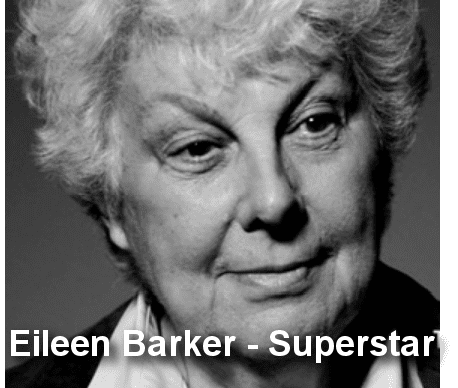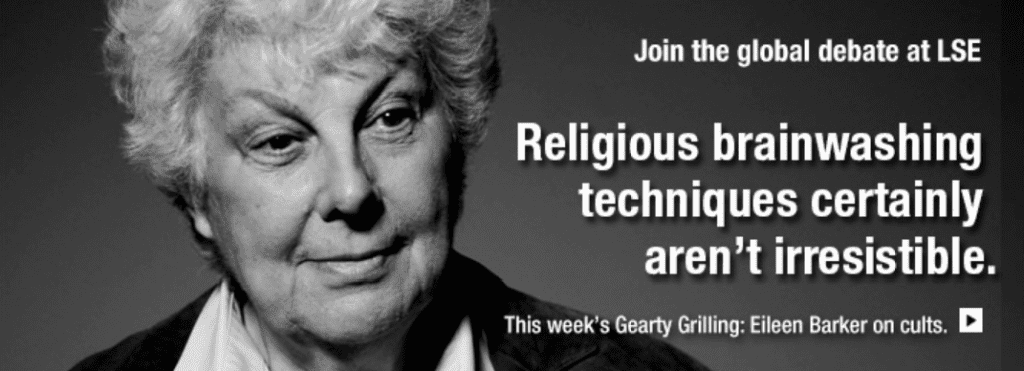This is an excerpt from sociology professor Eileen Barker at the London School of Economics.
A link to the full pdf is provided below.
I post it because it is a different view of ‘cults’ than we are given in the standard anti-cult movement’s narrative. I think this different, more objective view is healthier for an Ex-Scientologist to adopt after Scientology because social science provides many more constructive and productive concepts and perspectives to help an Ex understand his/her past involvement in Scientology.
For years, I thought of my own past involvement in Scientology exclusively using the ideas provided to me by the anti-cult movement. I did this, in part, because they seemed to be the only ideas about ‘cults’ available to me on the internet. I have since spent some time and thought going through what social science has to say about ‘cults’, rather than hunkering down exclusively in the tightly controlled bubble world of the anti-Cult movement’s Scientology Division. (aCSD)
As an Ex-Scientologist, it has been very helpful to me to learn these ideas from social scientists about ‘cults’.
I hope that it will be helpful to others, as well.
Here’s the excerpt from Eileen Barker’s paper.
________________
Protecting images
ACM (anti-cult movement) activists need not only to construct but also to defend their constructions in a market-place of competing images (Barker 2003). Part of their defensive strategy can involve challenging conflicting depictions, especially those of NRM scholars whom they may try to dismiss by labeling them as ‘cult-apologists’. The final section of this chapter offers examples of some of the ways those who are concerned to defend their images of cults as a social problem do so by attacking what they consider to be ‘the other side’. Several illustrations are of a personal nature, if only because my work has invoked a formidable array of examples!
Whilst publications by NRM (new religious movement) scholars are frequently ignored, there are two ways in which they do get ‘used’ by their antagonists in the cult wars: data deemed to be positive (or even neutral) are taken to ‘prove’ the scholar is a cult-apologist; data deemed to be negative are taken to show that even cult-apologists have to admit that the cults are a social problem.
This kind of ‘tails-you-lose, heads-I-win’ approach was adopted by an ACM reviewer when she reported, “the author focuses almost exclusively on her positive reframing and apologetic reframing [of the movements]” then concluded:
>Ultimately, I suppose we can thank Palmer for giving us more ammunition in the academic (and sociocultural) battle between those of us who believe that such groups are potentially harmful … and those who line up with the cult apologists. (Lalich 1997, 159-61)
Sometimes what has been written is taken completely out of context. In an article designed to demonstrate that ‘apologist NRM scholars’ have collaborated with the movements by presenting only positive images, one critic wrote:
>Barker (1991, p. 11) noted the ‘considerable economic advantages to be gained from being defined as a religion’, but has not suggested that this may motivate any specific NRMs or their leaders. (Beit-Hallahmi 2001, 57)
In fact, the entire paragraph from which the citation was lifted was devoted to suggesting that very thing.
A posting on a cult-watching website offers an interesting example of selective perception. It consists of an account of a lecture I had given, but bears little relation to my actual position or to what I had said, including a complaint that I had presented “a graphic image of the bombing of an ISKCON temple [but] no images of atrocities committed by cultic groups”.
In fact, my PowerPoint presentation had contained two graphic images of dead
bodies in Jonestown; one of the Branch Davidians compound in flames; a collage of bodies in the Tokyo underground and Aum Shinrikyo’s leader, Asahara; and a photo of the blazing Twin Towers. It was only after showing these that I had shown the picture of the bombed ISKCON temple – which was followed by a further picture of bunk beds containing the bodies of Heaven’s Gate members who had committed suicide.I have no reason to believe that the complainant was deliberately lying. I suspect he just had not remembered my showing the other pictures, which would have merely confirmed his taken-for-granted dichotomous worldview of ‘cults=bad vs. rest-of-society=good’. A proponent of cognitive dissonance theory might conclude that the inclusion of the unfamiliar ISKCON picture threatened his picture of reality and, to protect this, he had to reject the apparent inconsistency by proclaiming I was a cult apologist who presented only information defending the cults (Festinger 1956).
Perhaps less forgivable are occasions when complainants presumably know that they are fabricating the evidence. On an internet discussion group an avowed anti-cultist has attacked one of my books (Barker 1994), stating that I used methodological techniques I had explicitly not used, and giving a ridiculously inaccurate account of my findings. When another list member challenged the woman’s statements, she defended herself by saying that she had not read the book as, she claimed, she had tried to get it from Amazon ‘but even a used copy is more than $100.’ On checking Amazon that same day, I saw several copies on offer for under $5.
Then there are those who apparently consider any direct familiarity with my work would involve contamination. One of my students, attending a FAIR meeting, found herself being told about the terrible things I had written. The student, somewhat surprised, asked her informant where she had read these things, whereupon the woman replied in a shocked voice that she wouldn’t dream of reading any of my work.
One of the criticisms sometimes leveled against NRM scholars is that they are too academic; they cannot understand the situation because they have never lost a child to a cult. Several years ago I was asked to write a pamphlet for the Catholic Truth Society about the new religions. This I did, but it was rejected because, I was told, it was too objective. Another Catholic publication, The Clergy Review, did publish an article I wrote for them, whereupon the then-Chair of FAIR telephoned the editor demanding the right “to redress the balance as Barker’s article was so balanced!” When I asked another of FAIR’s Chairmen to give me examples of errors in my publications, he responded that he didn’t think I was wrong, just that by presenting two or more points of view I was “muddying the waters”. It was, he said, much easier for the FAIR membership if they had an uncomplicated picture of the situation.
Concluding remarks
‘Cult wars’ are likely to continue so long as there are new religions. What has been suggested in this chapter is that if we want to understand why there is a widespread perception of cults as a social problem it is necessary to study not only the NRMs, but also the various interests, methods and techniques involved in secondary constructions of the movements. This chapter has briefly introduced the complexity of the constructions of social life – but there is much, much more to be written on the subject.

